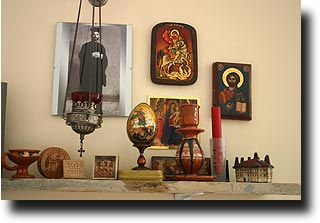Nearly every aspect of the meal is
wrapped up in traditions whose origin lie shrouded in history, but here
is an overview of some of the ones we learned about. At the start of the
slava, a priest comes to bless the house and the inhabitants, often showering
the place with incense, and a slava candle is lit - symbolizing God's light
of life - to burn throughout the meal.
A special slava bread (slavsky kolac)
is prepared with a cross cut into its top to remind visitors of Christ's
promise that "I am the living bread which came down from heaven" (John
6:51).
Next to it is placed a bowl of boiled wheat
mixed with honey and spices (kolyivo or slavsko zhito). The
wheat symbolizes several different things: it is in honor of the patron
saint, it is in memory of deceased relatives, it represents the death and
resurection of Christ, and it acts a reminder of the unity of Orthodox
Christians everywhere - set apart from the rest of the world.
The traditional drink is red wine, to represent
Christ's blood. It is also used to extinguish the candle at the end of
the celebration.







